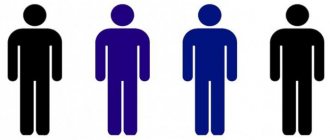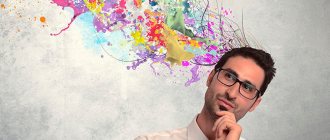Creative thinking and creativity are useful and indispensable skills of a modern person. However, it is difficult to find good courses, trainings, schools, books or textbooks for developing and improving these skills. For these reasons, we have developed this course to develop creative thinking and imagination.
If you've read 99 Francs or Generation P, watched the films of Tarkovsky or David Lynch, or seen the paintings of Leonardo da Vinci or Picasso, you've probably wondered: how can people create so many new interesting ideas and amazing concepts? So if these creative professionals make you want to be like them, you'll find a lot of useful information in our course.
The more unconventional life is, the more interesting it is to live. We are often required to be creative; the ability to think outside the box makes us witty, resourceful, successful, enterprising, lucky and rich. The ability to be creative can be useful always and everywhere.
It is often said that creative thinking cannot be taught, but this is not entirely true. Of course, a person’s innate abilities are very important, but usually it is adults who are truly characterized by creative thinking, the ability for which is not only innate, but acquired with education and experience.
Real works of art, as a rule, are created by adults who have achieved a certain skill in thinking and acting creatively. And if a person does not develop his creative potential, he is unlikely to achieve the ability to create, even if he showed any abilities in childhood.
This means there is something that creative people know and can do. They did not acquire this knowledge and skills genetically from their parents, but accumulated them throughout their lives. Let's try to find and unravel their secrets.
We also want to note that if you want to understand the topic of developing creativity in more detail, we recommend taking our “TRIZ in Practice” program, where in 4 weeks you will evaluate your creative abilities and learn ways to develop them, learn how to apply creative and inventive algorithms.
This course is dedicated to the basic skills of developing creative thinking. However, it will be even better if you take this course first and then move on to the advanced level. So feel free to get down to business, and we will start with a description of what you have to study.
Goals and objectives of the course
In general, the topic of the development of creative thinking can be explored almost indefinitely, finding in it ever new facets and shades. Therefore, we will not try to find the “Holy Grail” for which everything was started, but will point out several, in our opinion, the most important goals worthy of painstaking work on the creative component of your mind.
So, developed creative thinking and imagination will allow you to :
| 1 | Think outside the box. Thought patterns and clichés have long lost their relevance and only reduce a person’s effectiveness, no matter what it concerns. Developed creative thinking helps to find unexpected solutions to complex problems, overcome difficulties faster, work more productively, achieve more, and achieve results where others fail. |
| 2 | Achieve success. Starting a business, saving money, investing, negotiating, public speaking, making deals - everywhere you need a creative approach, because... It is he who makes a person head and shoulders above others, forms his reputation and authority, and helps him become an indispensable member of the team. However, creativity is useful even for a loader in a warehouse or an office manager in a small company. |
| 3 | Develop intelligence. Most truly creative people have high IQs. This means that the development of creativity has a cumulative effect on the development of intellectual abilities. You become smarter and more erudite, your horizons expand and your knowledge base expands, new neural connections are formed in your brain, which, among other things, has a beneficial effect on your health and even prolongs your life. |
| 4 | Be interesting. Creative thinking makes a person an interesting interlocutor with whom you can talk on different topics and have an unusual time. A sense of humor, communication skills, and the ability to constructively resolve conflicts also develop. Creative people, like a magnet, differ favorably from ordinary people, attract others and win loyal friends. |
| 5 | Develop spiritually. Creativity is always going beyond boundaries, and that is why, completely influencing a person’s personality, it makes him spiritual, looking deeper into things, seeing more than others. It’s no wonder that many creative people live in harmony with themselves and the world, clearly understand their mission and purpose, do what they love and draw happiness from every day they live. |
Whatever goals you set for yourself, be it purely pragmatic things, such as advancing your career, obtaining a doctorate degree or developing your own business, or something “out of this world”, for example, finding the meaning of life, creating unique objects of art or writing a novel, creative thinking everywhere will only play into your hands and will allow you to get closer to your dream much faster.
However, before you begin to develop creative thinking and creativity, you need to understand what exactly they are. Therefore, we want to continue with a little conversation about the meaning put into these concepts.
How to develop creativity
We have already indicated that creativity is related, but identical to such concepts as intelligence and talent, which means it can be cultivated and developed in oneself. Below are recommendations.
How can we do this differently?
To develop creativity, you should ask yourself this question in any situation. For example, you go to work from point A to point B through points C and D. Try to navigate your way through coordinates F and E. Along the way, analyze the changes you see and the emotions you experience. What new things did you discover along the way?
Try to apply approaches from other areas of knowledge and activity to your task
For example, when building a house, you can remember culinary recipes for multi-layered dishes and paint each floor with its own color.
Think about what could improve the quality and value of a job or thing.
The result of human activity in the workplace is a certain product, phenomenon or service. What additions could make it more competitive? At one time, tailors invented the pocket as a detail of clothing, wanting not only to decorate the dress, but also to add functionality to it. Thanks to this, today we have the opportunity to wear various little things in trousers and jackets.
Changing the structure or process of an activity
Analyze the technology of the activity, its sequence and the content of each stage. If the work process is carried out in stages, consider whether it is possible to change places, for example, B.C.A.D instead of the usual A.B.CD
Don't ignore random thoughts
Sometimes a person thinks carefully about a problem but does not find a solution. In such situations, spontaneous outbursts of non-standard thoughts and ideas occur. Such things should not be neglected. If they happen at night, they should be written down. Sometimes such things coming from outside contain valuable applied thoughts.
Try to abstract from knowledge and rely on intuition
With the development of Internet technologies, information haunts people; today you can find the answer to any question on your phone. If you want to develop creative thinking, you should limit yourself to receiving information from the outside.
Look around
For a creative person, the ability to think abstractly and associatively is important. While walking along the streets and parks, look closely and listen to the sounds and phenomena around you. Perhaps they will lead to thoughts that can be applied to solving problems or improving the state of the workflow.
What is creative thinking and creativity?
Explaining and describing what creative thinking is and what its features are is a rather difficult task. One of the few objective definitions of creativity/creative thinking was given by psychologist Oleg Konstantinovich Tikhomirov:
Creative thinking is one of the types of thinking characterized by the creation of a subjectively new product and new formations in the very cognitive activity of its creation. These new formations relate to motivation, goals, assessments, meanings. Creative thinking is distinguished from the processes of applying ready-made knowledge and skills, called reproductive thinking.
This definition highlights the main characteristic of creative thinking - the presence of a result, something subjectively new that a person creates. At the same time, it is important to understand that creative thinking or creativity is precisely a WAY to think, a certain PROCESS that leads to the creation of something new.
Naturally, there are many methods for organizing your thinking so that you can get something new as a result. A number of studies and tests show that most methods can be adjusted to certain logical circuits, which form part of the lessons in our course. And in order to understand the characteristics of your creative thinking, we suggest you take a special psychological test.
Signs of a creative mind
Creative thinking can be defined by the following criteria:
- fluency, speed, originality - in a short period of time, a creative person will offer many ideas, all non-standard;
- flexibility of thinking - a variety of strategies, tools, and capabilities are used to solve a problem;
- attention to detail - a creative person works out his idea to the smallest detail;
- abstract thinking - the ability to think in categories that do not exist in the real world, and also to transform them into accessible words.
The main criterion of creativity is resistance to patterns, the ability to abandon stereotypes and accept a huge amount of new information.
American psychologist Scott Barry Kaufman studied the concept of creativity for many years and as a result, he was able to identify 18 traits characteristic of creative individuals:
- these are dreamers - a person dreams when the consciousness is especially active, it is in this state that sudden insights occur, studies have proven that daydreaming uses the same parts of the brain and processes as creativity;
- these people are always observing - it is in the world around them that people draw inspiration and opportunity;
- they work only when they work best - for some it is early morning, and for others it is late at night; it is around their creativity that such people build their lives;
- It is important for them to be alone - according to statistics, creative people created their best work when they were alone;
- such people benefit from any difficulties in life - difficult situations become a catalyst for the creation of real masterpieces, by the way, in psychology there is a whole direction that studies post-traumatic states, as a result of which outbreaks of creativity occur;
- such people have good taste because they surround themselves with beautiful, refined things;
- a creative person is a visionary, that is, he is able to see connections between things that seem unrelated to other people;
- Such people cannot stand routine and monotony; they constantly rearrange furniture and try something new in life.
Creative people are also interested in everything new, they are curious, observant, they often take risks, and they are not shy about expressing themselves.
Quite often, creativity is accompanied by failures and defeats, since people with non-standard thinking are in constant search and do not rest until the result meets expectations. The more difficult the task is, the more enthusiastically a creative person takes on its implementation - this is a kind of passion, a desire not for financial gain, but for the realization of his creative ideas and ideas.
Interesting fact! When a creative person creates, he can enter a special state of “flow,” thus achieving the highest concentration and calmness. At such a moment, nothing and no one can throw him out of balance and distract him from the creative process.
What influences our level of creativity?
In this context, it is appropriate to touch upon the topic of barriers that impede the development of creativity. The fact is that most of these barriers are created by a person himself - these are artificial restrictions imposed by society, the environment, internal traps.
- Barrier #1 is the desire for certainty.
It is vital for an adult to feel confident in the future and clearly understand the essence of the task at hand. Any uncertainty is accompanied by the desire to eliminate it, and for this, thinking finds the simplest way. However, the clearer and more accessible the problem is formulated, the simpler the solution will be; accordingly, there is no room left for creativity.
Important! Creativity cannot exist without uncertainty. Imagine a fire, add oxygen and it will burn brighter, remove oxygen and the fire will go out. Uncertainty is the oxygen for creativity. How to get uncertainty? Just step outside your usual comfort zone.
- Barrier No. 2 - we are afraid of other people's assessments.
Any new business is a fear of mistakes and failures, of universal condemnation. This is why people prefer to solve problems in their usual way, without inventing anything new. If fear is based on the condemnation of loved ones, whose opinion is important, it increases several times.
- Barrier No. 3 - low self-esteem and stereotypes.
Lack of self-confidence is a serious obstacle to the development of innovative thinking. And an underestimate, seasoned with a whole bunch of stereotypes, principles, habits, internal attitudes - this is generally an explosive mixture that not only affects, but eradicates the possibility of creating something truly creative.
Important! Do you want to change something in your life? Feel freedom? Start getting rid of one of the main stereotypes - you can think creatively only in childhood. In fact, you can develop non-standard thinking at any age - change your habits gradually, introduce new principles. Yes, this will require effort, since you will have to constantly work on yourself.
Creative thinking and work
Creativity is not only valued, but welcomed and necessary for many experts - photographer, designer, SMM manager, marketer, event organizer. Experts predict that in the near future, about 60% of professions will become automated, and humans will be in demand only where creativity is required - qualities that artificial intelligence cannot master and understand.
Today, many advertising agencies have the position of creative director, who manages a staff of designers, proposes ideas, and is responsible for the final product. In modern realities, creativity is not a whim, but a mandatory requirement. So, what do employers mean when they want to see this quality in a person, and how to write a resume correctly to avoid mistakes.
- Keep it in moderation. When it comes to creativity, a sense of proportion is necessary above all. If you give in even a little to the impulse and don’t stop in time, the result will turn from stylish and original into bad taste. Of course, first of all, you need to remember your immediate responsibilities and only then think about creativity.
- Your claim of creative thinking must be supported by a portfolio. You must prove your abilities with real results.
- Try to describe your abilities as clearly and in detail as possible.
Creativity Test
This test was created as an interpretation of the methodology for diagnosing personal creativity, developed by Elena Evgenievna Tunik, candidate of psychological sciences, and allows you to determine four characteristics of a creative personality: curiosity, imagination, complexity and risk-taking.
To correctly interpret the answers, you should adhere to several rules when taking the test:
- Among the short offers offered, you will find some that definitely suit you better than others. For them you should select the answer “Yes”. Some proposals are only partially suitable for you; you should answer “Maybe”. Other statements will not suit you at all; the answer for them is “No”. For those statements about which you cannot come to a decision, the last option is provided - “I don’t know.”
- There are no right or wrong answers here. Mark the first thing that comes to your mind when reading the sentence. This task has no time limit, but work as quickly as possible. Remember that when giving answers to each sentence, you must note what you really feel. Choose only one answer for each question.
- Since the test is based on personal perception, you should not expect it to be an objective test of your abilities. To a greater extent, it reflects your idea of your creative abilities. Remember that creativity is not an innate characteristic, but a quality that can be developed.
- The test data will be recorded after you answer the last question and see confirmation of the end of the test. If you finish the test before the last question and close the page, the data will not be saved.
Statistics Full screen
On the other hand, creative thinking is associated not so much with logical schemes, but with developed associative thinking and human imagination. All this can be developed with the help of special exercises, which represent another important component of the course.
What it is
Creativity, or creative thinking, is an activity that results in a person creating something completely new. To do this, he uses not only initial data, but also associations, experience, personal perception, imagination, and internal sensations. The result is an absolutely unique product.
It is studied in the psychology of creativity - a separate section devoted to the study of the creation of everything new by man in science, art, technology, everyday life and everyday life. It also examines creative potential - how it is formed and developed. This data is actively used in other areas:
- cultural-historical psychology;
- existential;
- humanistic;
- cognitive;
- psychoanalysis;
- activity approach;
- Gestalt therapy.
The potential of creative thinking is used not only in psychology. They are also interested in other sciences: philosophy, sociology, political science, pedagogy, computer science. Today, one of the recruitment criteria for many large companies is creativity. It is necessary not only for artists, film directors, poets and musicians. Many modern professions also require the ability to create something completely new and unique. These are designers, stylists, copywriters, marketers, advertisers, etc.
How to learn to think creatively?
As has already been said, there are many approaches to understanding creative thinking, and therefore there are many ways to teach such thinking. Among the popular approaches to analyzing creativity are :
| 1 | the concept of lateral thinking; |
| 2 | theory of solving inventive problems; |
| 3 | synectics; |
| 4 | six hats method; |
| 5 | some other methods. |
Most of these approaches have similar features, but if you try to do all of these methods at the same time, you can get confused.
Having analyzed many approaches to creativity, we came to the conclusion that the most universal theory is the concept of lateral thinking by Edward De Bono (as well as its interpretation by Philip Kotler), which is aimed at understanding the logic of constructing new ideas. It is the concept of lateral thinking that forms the basis of this course. It also used a number of important techniques for developing creative thinking from other theories to expand on de Bono's concept.
In addition, concepts that deserve special attention have been included in a separate lesson so that you can try different techniques for developing creative thinking. But let's not get ahead of ourselves, but talk about this in due time. For now, it’s enough to get acquainted with what awaits you in the lessons.
Creativity in the modern world
Modern society is involved in the processes of market globalization and increased competition. You need to quickly respond to changes, apply non-standard solutions, and generate new original ideas. Society needs unusual solutions to familiar problems, new approaches to solving known and seemingly studied problems, as well as new ways of behaving in typical situations. Most professions in the modern world require creativity and the activation of creativity. Creative thinking manifests itself in the modern socio-economic system in various forms. These include scientific discoveries, entrepreneurship, technical inventions, the creation of works of art, relationships with people, and public administration.
Lessons on Creative Thinking
The course is divided into several lessons that are designed to reveal different aspects of creative thinking in you. By completing all the lessons, you will gain the necessary basic knowledge that will help you apply and continually improve your creative thinking.
Lesson 1. Lateral thinking
To think outside the box and create something truly new, it is useful to understand how to break the mold and come up with a new idea. This lesson will describe Edward de Bono's lateral thinking scheme as interpreted by the famous marketer Philip Kotler. Understanding the creative thinking process will help you understand how to make your creative process more productive.
Lesson 2: Framing and Focusing
To create something new, you must choose the direction of your creative search. Without such a starting point it is simply impossible to move on. No matter how strange it may seem, the more clearly you define the framework, the easier it will be to create something new. This lesson shows the importance of choosing a focus and examines Robert Dilts' language focus patterns (framing), based on which you can begin the process of lateral thinking.
Lesson 3. Breaking the pattern
When you know the algorithm for how to purposefully look at things from different angles, you can find the most appropriate focus (frame) in any situation. But something new has not yet appeared, because... we simply changed the angle of view without changing the object itself. The process of lateral thinking has just begun. To continue it, it is necessary to perform what is called a “lateral break” (template break, shear or displacement). It is breaking the pattern that will help break the logic of thinking in order to come to new ideas.
Lesson 4. Developing creative imagination
After making a lateral break, many, mostly illogical (lateral) judgments appear. Now we have to take a step aimed at eliminating the resulting gap in the pattern. The upcoming stage is associated with work on the development of creative imagination to search and create full-fledged creative ideas from the metamorphoses obtained in the previous stages. This lesson describes the methods, principles and features of developing creative imagination, and also contains useful techniques, exercises and games.
Lesson 5. Developing creativity
At the last stage, in addition to creative imagination, human creativity also plays an important role - the ability to accept and create fundamentally new ideas that deviate from traditional or accepted patterns of thinking. It is important to note that creativity is a heterogeneous property that has several characteristics. The most common are the characteristics identified by the famous American psychologist Joy Paul Guilford back in the 60s of the last century. They will be discussed in the lesson.
Lesson 6. Theories of creativity and creativity
Back in the 16th century, the outstanding English philosopher Francis Bacon complained that scientific discoveries were slow and largely accidental. He tried to find approaches and algorithms that would make it possible to turn the “creation of new things” into a systematic, constant process. A lot of time has passed since then, and today society has at its disposal a lot of theories of creativity and creativity that help us look outside the box at existing problems and propose non-trivial solutions. In this lesson we will review the most well-known and widely used techniques and concepts.
Textbooks and books
Reading books is a very effective way to develop creative thinking. While reading, active visualization of what you are reading occurs. And because Apart from the letters that make up words and sentences, you do not receive any additional information; you inadvertently have to imagine a picture of what is happening. It is especially useful for the development of creativity to read science fiction, adventure, detective stories and, of course, poetry. But there are also separate books and textbooks about creative thinking. We will tell you about them.
Creative games
The development of creative thinking cannot occur only by studying special algorithms and rules for searching for new ideas. Practice matters a lot. This section presents games for developing creativity. Here you can find games of various types - both independent online games and group games and creative tasks for training creativity without the use of a computer.
Additional materials
In one fairly comprehensive course it is impossible to cover all the important and necessary information, especially on such a serious topic. Therefore, in order for you to better understand everything, we advise you to read several additional articles, as well as take our in-depth programs, one way or another related to the topic under consideration. Be sure to study this section and pay attention to what interests you.
Development of creative thinking
The author of the bestseller “The Birth of a New Idea,” American researcher E. De Bono, successfully worked on the problem of developing creative thinking. He developed a comprehensive program for the development of creative thinking and identified the following basic principles:
- Determining the conditions for solving a problem that are necessary and sufficient to achieve the goal.
- Willingness to abandon previously gained experience in solving similar problems.
- Improving the ability to notice multifunctional, universal things.
- Connecting a variety of different, even opposing ideas from a variety of fields of knowledge and using the resulting associations to solve problems.
- Improving the ability to understand the prevailing idea in a given field of knowledge, so as not to fall under its influence.
The formation of creative thinking presupposes, firstly, the unity of logic and thinking; secondly, the unity of positivity, harmony and productivity. The third necessary component is the joy of self-development.
We can identify a number of skills without which one cannot achieve success in the modern world, but which, fortunately, can be developed in oneself. They can be learned:
- Ability to think logically.
- Ability to formulate assumptions.
- The ability to find logical connections between phenomena, objects, facts.
- Ability to overcome stereotypes.
- Ability to make decisions in atypical, new situations.
- Ability to find the necessary knowledge and suitable methods.
Amaystyle T.M. identified three main elements of creativity:
- competence (availability of knowledge base, experience, skills);
- creative thinking (use of creative thinking methods, ingenuity, flexibility, perseverance;
- motivation (internal and external). Intrinsic motivation is personal interest in solving a problem, a persistent desire to apply knowledge, and self-realization. External motivation - career advancement, financial interest.
How to take the course?
As we said, in this course we tried to cover only basic information regarding the topic of developing creative thinking. And precisely for this reason, we strongly recommend not to miss a single lesson and study them in the order in which they are presented.
As for the actual classes, it all depends on your desire and availability of free time. But the best option would be if it takes you 1-2 days to study one lesson so that the information is absorbed properly. Also try to complete all tasks and exercises, because they directly affect the result. The more you practice, the more useful the practice will be.
Definition
Creative thinking - what is it in psychology
Human creative thinking is the process of getting acquainted with information, processing it and creating new ideas. In pedagogy, the importance of this type of thinking is noted due to the fact that the individual independently strives to obtain new knowledge and quickly apply it in practice. This applies not only to music and drawing lessons, but also to history, social studies, etc. In addition, speaking about children with a predisposition to this type of thinking, the importance of having this criterion for learning, as well as socialization, is noted.











